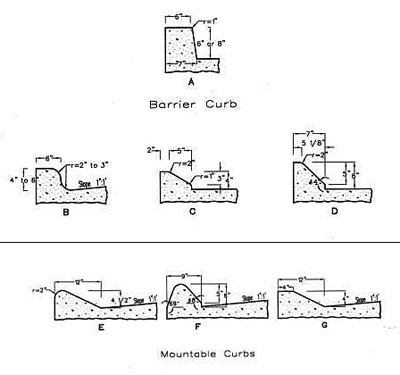Curbs and Gutters
Requirements for Curbs
Advantages | Types | Requirements | Design | AASHTO Standards | Joints | Drainage | Materials | Construction
Curbs must meet several basic requirements if they are to serve their intended purposes and have long service life. Curbs must have the required mass, stability and strength to withstand the impacts of traffic and the effects of their environments and to maintain their positions even when crossed by traffic or struck by snowplows. They must have the strength to bridge small areas where subgrade support is inadequate.
 The standard sections shown here have been proven to have the necessary mass for strength and stability. Separate curb and gutter sections should be at least two feet wide with greater widths having more stability for a relatively small amount of construction costs.
The standard sections shown here have been proven to have the necessary mass for strength and stability. Separate curb and gutter sections should be at least two feet wide with greater widths having more stability for a relatively small amount of construction costs.
In severe environments, curbs must have adequate durability to resist freeze-thaw cycles while being buried in snow and ice plowed to the sides of streets and being saturated with brine from deicing salts that is carried to the sides.
Another important requirement is visibility. Because of their light and reflective surfaces, concrete curbs can be easily seen, even at night when pavements are wet. The washings of rain and the removal of debris by street sweeping are sufficient to meet this requirement.


